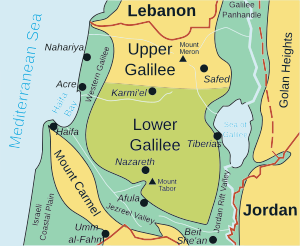
The Upper Galilee (Hebrew: הגליל העליון, HaGalil Ha'Elyon; Arabic: الجليل الأعلى, Al Jaleel Al A'alaa) is a geographical region located in northern Israel. Part of the larger Galilee region, it is characterized by its higher elevations and mountainous terrain. The term "Upper Galilee" is ancient, and has been in use since the end of the Second Temple period. From a political perspective, the Upper Galilee is situated within the administrative boundaries of the Northern District.
The Upper Galilee is known for its natural beauty, including lush landscapes, Mediterranean forests, and scenic vistas. Significant natural sites include Nahal Amud and the Keshet Cave. It's also an area where vineyards and wineries thrive, producing quality wines. Mount Meron stands as the highest point in the area, reaching an elevation of 1,208 meters above sea level. Safed is a main city in the region.
Several historical definitions have expanded the Upper Galilee's boundaries to encompass portions of southern Lebanon as well.
Originally, the term "Upper Galilee" referred to a larger region, encompassing the mountainous regions of what is today northern Israel and southern Lebanon. The boundaries of this region were the Litani River in the north, the Mediterranean Sea in the west, the Lower Galilee in the south (from which it is separated by the Beit HaKerem Valley), and the upper Jordan River and the Hula Valley in the east.[1]
According to the first century Jewish historian Josephus, the bounds of Upper Galilee stretched from Bersabe in the Beit HaKerem Valley to Baca (Peki'in) in the north, and from Meloth to Thella.[2] The extent of this region is approximately 470 km2.[3]
In present-day usage, the toponym mainly refers only to the northern part of the Galilee that is under disputed Israeli sovereignty. That is, the term today does not include the portion of Southern Lebanon up to the Litani River, or the corresponding stretches of the Israeli Coastal Plain to the west, or the Jordan Rift Valley to the east. These are considered to be separate geographical areas that are not part of “Upper Galilee.”[citation needed]
The Upper Galilee is home to numerous significant ancient synagogues, dating from Roman and Byzantine times. Those include the synagogues of Bar'am,[4] Nabratein,[5] Gush Halav,[6] Huqoq,[7] Chorazin,[8] Meron[9] and a few others. Remains of synagogues has also been found in Qision[10] and Alma.[11]

Following the dissolution of the Ottoman Empire and the Balfour Declaration in which the British Empire promised to create "A Jewish National Home" in Palestine, the Zionist Movement presented to the Versailles Peace Conference a document calling for including in the British Mandate of Palestine the entire territory up to the Litani river — with a view to this becoming eventually part of a future Jewish state.
However, only less than half this area was actually included in British Mandatory Palestine, the final border being influenced both by diplomatic maneuverings and struggles between Britain and France and by fighting on the ground, especially the March 1920 battle of Tel Hai.
For a considerable time after the border was defined so to make the northern portion of the territory concerned part of the French mandated territory that became Lebanon, many Zionist geographers — and Israeli geographers in the state's early years — continued to speak of "The Upper Galilee" as being "the northern sub-area of the Galilee region of Israel and Lebanon".
Under this definition, "The Upper Galilee" covers an area spreading over 1,500 km2, about 700 in Israel and the rest in Lebanon. This included the highland region of Belad Bechara in Jabal Amel located in South Lebanon,[12] which was at for some time known in Hebrew as "The Lebanese Galilee".[1] As defined in geographical terms, "it is separated from the Lower Galilee by the Beit HaKerem valley; its mountains are taller and valleys are deeper than those in the Lower Galilee; its tallest peak is Har Meron at 1,208 m above sea level. Safed is one of the major cities in this region".
In recent decades, however, this usage has virtually disappeared from the general Israeli discourse, the term "Upper Galilee" being used solely in reference to the part located in Israel.